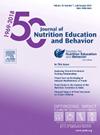美国早期护理和教育环境下儿童饮料消费,2008-2020。
IF 2.3
3区 医学
Q2 EDUCATION, SCIENTIFIC DISCIPLINES
引用次数: 0
摘要
目的:描述2008年至2020年间美国多个州早期护理和教育(ECE)环境中幼儿的饮料摄入量。方法:对ECE中心和家庭(n = 846) 12-60月龄儿童(n = 4,457)的饮料消费进行多变量调整、年龄分层估计。结果:在ECE的任何一天,幼儿每餐饮用牛奶的概率为79.7%,8.9%的水,19.8%的100%果汁和3.2%的含糖饮料(SSBs),每餐平均摄入1.5盎司牛奶,1.7盎司水,2.2盎司100%果汁和2.9盎司SSBs。年龄较大的儿童饮用牛奶、0.6%水、2.9% 100%果汁和4.2% SSBs的可能性为87.2%,平均摄入量为4.2盎司牛奶、2.3盎司水、3.6盎司100%果汁和5.9盎司SSBs。结论和意义:欧洲经委会的饮料摄入量有改善的空间,重点是增加水和减少果汁和SSB的消耗。这些结果可能证明限制或禁止欧洲经委会果汁消费的政策是合理的。本文章由计算机程序翻译,如有差异,请以英文原文为准。
Child Beverage Consumption in US Early Care and Education Settings, 2008–2020
Objective
Describe young children's beverage intake in early care and education (ECE) settings between 2008 and 2020 across multiple states in the US.
Methods
Multivariable-adjusted, age-stratified estimates of beverage consumption among children aged 12–60 months (n = 4,457) in ECE centers and homes (n = 846).
Results
During any given day in ECE, younger children had a 79.7% per-meal probability of consuming milk, 8.9% water, 19.8% 100% juice, and 3.2% sugar-sweetened beverages (SSBs), and a per-meal mean intake of 1.5 oz milk, 1.7 oz water, 2.2 oz 100% juice, and 2.9 oz SSBs. Older children had an 87.2% probability of consuming milk, 0.6% water, 2.9% 100% juice, and 4.2% SSBs, and a mean intake of 4.2 oz milk, 2.3 oz water, 3.6 oz 100% juice, and 5.9 oz SSBs.
Conclusions and Implications
There is room to improve beverage intake in ECE, with a focus on increasing water and decreasing juice and SSB consumption. These results may justify policies to limit or prohibit juice consumption in ECE.
求助全文
通过发布文献求助,成功后即可免费获取论文全文。
去求助
来源期刊
CiteScore
4.20
自引率
11.50%
发文量
379
审稿时长
44 days
期刊介绍:
The Journal of Nutrition Education and Behavior (JNEB), the official journal of the Society for Nutrition Education and Behavior, is a refereed, scientific periodical that serves as a global resource for all professionals with an interest in nutrition education; nutrition and physical activity behavior theories and intervention outcomes; complementary and alternative medicine related to nutrition behaviors; food environment; food, nutrition, and physical activity communication strategies including technology; nutrition-related economics; food safety education; and scholarship of learning related to these areas.
The purpose of JNEB is to document and disseminate original research and emerging issues and practices relevant to these areas worldwide. The Journal of Nutrition Education and Behavior welcomes evidence-based manuscripts that provide new insights and useful findings related to nutrition education research, practice and policy. The content areas of JNEB reflect the diverse interests in nutrition and physical activity related to public health, nutritional sciences, education, behavioral economics, family and consumer sciences, and eHealth, including the interests of community-based nutrition-practitioners. As the Society''s official journal, JNEB also includes policy statements, issue perspectives, position papers, and member communications.

 求助内容:
求助内容: 应助结果提醒方式:
应助结果提醒方式:


